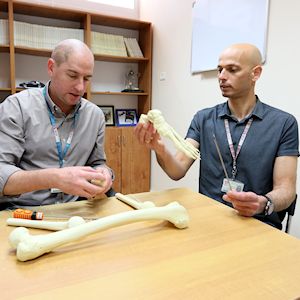News and Events
Rambam Doctors Awarded NIS 500,000 Grant to Develop Surgical Patent
Two orthopedists from Rambam Health Care Campus had an idea to improve the accuracy of certain orthopedic surgeries. They have just received a half million shekel grant to make their idea a reality.
 (L-R) Dr. Yaron Berkovich with Dr. Yaniv Keren.
Photographer: Pioter Fliter
(L-R) Dr. Yaron Berkovich with Dr. Yaniv Keren.
Photographer: Pioter Fliter
Picture this… A complex surgery is being performed on a patient with a serious injury; the orthopedist pauses for a moment and considers how much better the procedure would be, and how much faster the patient would heal, if the tools being used could just be improved upon… and then the surgeon continues with his work.
This is exactly what happened to two orthopedists from Rambam Health Care Campus, Drs. Yaniv Keren and Yaron Berkovitz. Dr. Keren is a specialist in treating complicated orthopedic shoulder, knee, ankle, and other joint injuries. Dr. Berkowitz is a specialist in knee and thigh joint transplants.
Both doctors have been struggling with an issue that has been challenging orthopedists around the world for some time: how to re-attach a tendon which has become separated from the bone due to injury. Accepted practice uses an 'anchor,' a screw mechanism made of metal or biodegradable material, to bind the tendon or injured strip to the bone. Once the anchor is screwed into the bone, a suture is sewn to the tendon, to reattach the tendon to the bone. While practical, these anchors can be associated with a wide range of complications: they are often too short or thin, and fixing them to the bone at the exact angle is time-consuming and challenging.
The two doctors invented a new anchor: a thin fixed-length cylinder—based on recognized standards—is made with the anchor placed in one end of the cylinder. The cylinder length can be adjusted via two slots. The cylinder slides over the tip of a standard surgical drill, enabling quick insertion and automatic placement of the anchor in the desired location.
The device represents an innovation in fixing the anchor in place via the drill: the orthopedist can now determine the precise screw length needed, enabling precise placement of the anchor in the bone. The result is quick placement of a strong anchor.
This amazing invention might have simply just lingered in the minds of doctors Keren and Berkovitz, as they rushed from surgery to surgery in a hospital overcrowded with trauma victims. It was at this point that the "Spark" proof-of-concept program entered the picture. "Spark," initiated by Professor Rafi Bayer a few years ago, operates under the umbrella of "Rambam MedtTech," the technology transfer company for research performed at Rambam Health Care Campus.
"Spark" provides a first stage proof-of-concept grant to physicians with new and innovative ideas. In this case, it was a perfect match: the "Spark" grant provided doctors Keren and. Berkovitz with the initial push needed to bring their idea to the next stage—patent registration process. It also led to their being awarded the prestigious NIS 500,000 research grant from the Chief Scientist of the Ministry of Health. This grant will facilitate progress from the final stages of patent registration to the manufacture of their invention. Within a few years their device may be used by every orthopedist in the world. And it all started with one small spark at Rambam.

